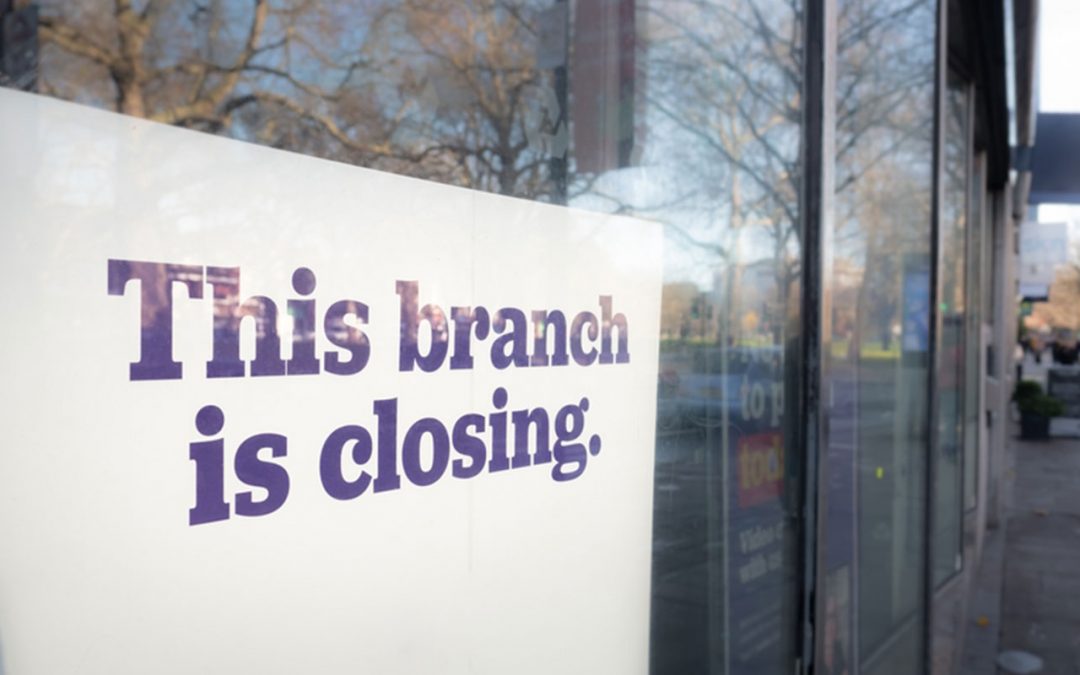Over the past few years, bank and building society branches have been disappearing from our high streets at a frightening pace.
Banks say that this has been driven by a rapid increase in online and mobile banking, and a rapid decline in the use of physical branches.
Which? has been tracking bank branch closures since 2015. In this guide, you can find out exactly what the state of play is, which banks have closed the most branches and the areas hardest hit.
And our bank branch closure checker allows you to find out which of your local branches closed recently.
How many bank branches have closed since 2015?
Banks and building societies have closed (or scheduled the closure) of 5,579 branches since January 2015, at a rate of around 54 each month. Along with the rest of the figures in this article, this includes branches at 20 major current account providers.
The NatWest Group, which comprises NatWest, Royal Bank of Scotland and Ulster Bank, will have closed 1,299 branches by the end of 2023 – the most of any banking group.
Lloyds Banking Group, made up of Lloyds Bank, Halifax and Bank of Scotland, has shut down 926 sites, rising to 1,007 in 2023.
Barclays is the individual bank that has reduced its network the most, with 1,029 branches having closed – or scheduled to – by the end of 2023.
This chart shows the actual number of branches each bank and building society has closed since 2015.
*Virgin Money includes banks previously branded as Clydesdale and Yorkshire Bank
Use our bank branch closure checker
To find out whether your local bank branch is closing or has recently closed, we’ve created a unique tool to show shutting down branches in your local authority.
Simply select your bank and enter your postcode to find out which branches closed recently and which are about to be lost.
As this tool is continually being updated, it may not include branches from very recent rounds of closures.
*Up to date as of 31/03/2023
Which banks have closed the most branches since 2019?
Bank branch closures reached their peak in 2017, when 867 sites were lost around the UK, at a rate of more than 70 a month. Similarly, some 792 branches closed in 2018.
In 2019, the rate of closures slowed, although some 444 branches still shut their doors for good.
2020 saw the lowest number of branch closures (369), as several banks shelved plans due to the pandemic. Barclays closed the most branches in 2020 (105), followed by TSB (91).
Unfortunately it took less that three months for the number of bank closures planned for 2021 to outstrip those in 2020, eventually reaching 735 for the whole year.
Closures continued into 2022, with a final count of 662 closures by the end of the year. Barclays once again had the most shuttered branches (184).
Already there have been 76 closures in 2023, with another 330 scheduled for later in the year. HSBC leads the pack with 114 already penciled for shuttering, followed by NatWest with 106 set to close and Barclays with 69. Others with branches shutting in 2023 include Lloyds with 62, Halifax with 32, TSB with nine, Santander with five, Bank of Scotland with four, Nationwide with two, RBS with two and Virgin Money with one.
Of note, M&S Bank closed all its in-store branches at the end of summer 2021 when it stopped offering current accounts, while Metro Bank announced three closures in 2022 – its first closures since we started recording data in 2015.
The chart shows the number of closures (and scheduled closures) at every brand between January 2019 and December 2023.
Which areas have been hardest hit by bank branch closures?
In terms of volume, the South East has seen the biggest reduction in branches since 2015, with 721 shuttered and another 53 scheduled to close.
However, Scotland was the first part of the UK to see over half of its banks close, with 584 of its 1,040 branches now gone and another 12 set to go.
Royal Bank of Scotland has closed 160 branches in Scotland since 2015, while Bank of Scotland has shut 128.
In the South East, 151 Barclays branches have been shuttered, as well as 131 Lloyds branches and 126 NatWest branches.
This chart shows bank and building society losses at a regional level from January 2015 to the end of 2023 (including scheduled).
Local bank branch closures: how does your area fare?
We’ve also broken down the data at the level of parliamentary constituency to get an even more granular snapshot of where losses are being most keenly felt.
Wentworth and Dearne in Yorkshire has the dubious distinction of being the first constituency to lose all of its branches.
It has since been joined by 10 more: Sheffield Hallam, St Helens North, Newport East, Mid Derbyshire, Bradford South, Nottingham East, Glasgow North East, Warrington North, Liverpool West Derby and Erith and Thamesmead; while a further 39 constituencies are down to their last branch.
Look up your parliamentary constituency in this table to see what the state of play is where you live.
What’s being done to protect access to cash?
In the May 2022 Queen’s Speech, the government pledged to bring forward a Financial Services and Markets Bill following a longstanding Which? campaign calling for cash access to be protected.
The Financial Services and Markets Bill aims to ‘strengthen the United Kingdom’s financial services industry, ensuring that it continues to act in the interest of all people and communities’.
Part of this includes making sure people across the UK can access their own cash with ease.
The government has confirmed the Financial Conduct Authority (FCA) will be given new powers over the UK’s biggest banks and building societies to help protect the future of cash.
These new powers will allow the FCA to address cash access issues at both a national and local level. However, separate rules will apply in Northern Ireland due to the different nature of the banking market.
To support the FCA, the government said it will set out its expectations for a reasonable distance for people to travel when depositing and withdrawing cash in due course.
Banking hubs – will your town get one?
Under pressure from campaigners and the government, major high street banks (Bank of Ireland, Barclays, Danske Bank, HSBC, Lloyds Banking Group, Nationwide, NatWest Group, Santander, TSB, and Virgin Money) have finally agreed to fund shared hubs on a voluntary basis.
Since January 2022, these banks tell Link (the cash machine network) when they’re planning branch closures so it can assess whether that community needs extra cash services, such as a hub.
Communities can also ask Link directly to be assessed.
By the end of 2022 only two new hubs had opened – in Brixham and Cottingham (East Riding of Yorkshire), joining existing trial hubs in Cambuslang (Lanarkshire) and Rochford (Essex). A further 47 are in the pipeline – but they could take years to appear, while other communities could be left without face-to-face banking entirely.
The table below lists the current Link recommendations for banking hubs and deposit services in the UK.
What can I do at a banking hub?
Hubs provide counter services run by Post Office staff, where personal and business customers of any bank signed up to the Banking Framework Agreement with the Post Office can carry out basic services such as deposits, withdrawals and paying bills.
They also include private spaces for more complex inquiries, and community bankers on rotation. For example, the Brixham banking hub is shared by Barclays, Lloyds, NatWest, Nationwide and Santander. The hubs are open 9am to 5pm Monday to Friday as standard, but services offered by community bankers are determined by the firms, and may vary due to customer needs.
In contrast, deposit services could be as basic as an automated machine at a local post office or public library, with no face-to-face services. Link told Which? deposit services are primarily to support small businesses and will be recommended where there is a higher demand for retailers to be able to deposit takings, or in places where the remaining banks don’t serve businesses.
What are the alternatives to bank branches?
Under the Access to Banking Standard, introduced in 2015, banks have a requirement to engage their customers and communities ahead of planned closure, and offer alternative means of banking when a branch closes. Banks must also inform the FCA.
These are some of the solutions on offer:
Using the Post Office
According to UK Finance, 99% of retail banking customers can carry out basic banking at the more than 11,500 Post Offices across the UK.
Post Office banking services are limited to these activities:
- Withdrawing cash from your current account
- Checking your balance
- Paying in cash and cheques (for cheques, you’ll need a paying-in slip from your bank and an extra day or two for them to clear)
The list of what you can’t do is substantially longer, whether transferring money from your account, or seeking advice and making enquiries about other financial products such as savings or mortgages.
Banks themselves usually demand that customers call into a local branch for anti-fraud checks, or to make an appointment to discuss more complex matters and important legal documents, such as lasting power of attorney or grant of probate.
None of these tasks can be completed at a Post Office.
For more on the effect of bank branch closures on communities, and the limitations of the Post Office as an alternative to bank branches, read our news story and watch the video below:
Mobile banking vans
Both the NatWest Group and Lloyds Banking Group offer mobile banking vans, which visit local communities and allow you to cash cheques, make deposits and withdrawals, and pay bills.
They typically visit rural and semi-rural areas once a week. Hit the links to find out where NatWest,Royal Bank of Scotland, Lloyds Bank and Bank of Scotland operate.
Community bankers
NatWest Group deploys ‘Community Bankers’ – professional bank staff who travel to areas with no branches and meet customers in shared local spaces, such as libraries, council buildings or leisure centres.
They can have discussions about financial issues, help people find out other ways to bank and at least give customers without a branch face-to-face assistance.
Tech support
Many banks offer help to get people feeling comfortable with using mobile and online banking.
RBS has a team of TechXperts, based in branches helping people set up online and mobile banking. They can help people download apps on their devices and show customers how to use them.
Barclays runs a similar initiative through its Digital Eagles, also helping customers use the internet for broader tasks, such as online shopping, setting up email address and staying safe online.
Support our Freedom to Pay campaign
Cash is a necessity millions couldn’t live without, and a backup for everyone when online systems fail. But with card and digital payments becoming more and more popular and bank branches closing at an alarming rate, we’re concerned some people may be left behind.
Which? research on bank branch closures
Which? collected bank branch closure data by tracking announcements and contacted banks to confirm our figures. When a bank has refused to do this we have included our unconfirmed figures. Only Barclays has not confirmed its data on branch closures.
This article originally appeared on WHICH?
Written by Which? Money Team
For more information on Safe Deposit Boxes and Safety Deposit Box Services contact Soteria Safes.


Recent Comments